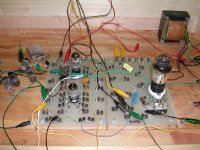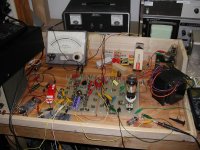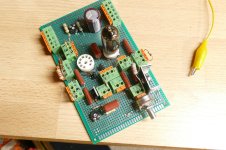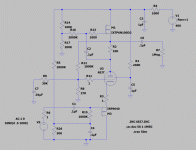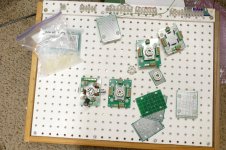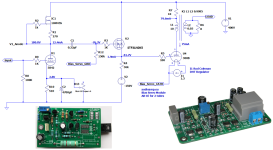Hi. The plan for my tubelab SE was to fill the role of HF amp in my 3-way tri-amped system. The amp sounds great but unfortunately, the gain is 7.5dB less than my LF and MF amps.
Rather than continuing to sacrifice 7.5dB of gain in the LF and MF in my crossover, I’ve been looking at ways of increasing the gain of the tubelab SE.
Any alternative needs to be a single 9-pin noval tube so I don’t have to go changing the metal work.
I’ve done some modelling in LTSpice with a 12AX7 running at 1mA, parallel 12AX7s with 1mA each, and with the 12AX7s configured as a mu follower. Ignore for now that 1mA would require a different CCS.
Here’s the gains and distortions for 0.1W out and 1W out.


According to the simulation at least, the 12AX7 mu follower looks to be a good option, apart from the upper stage needing heater elevation.
Is there anything I'm missing? As a high-transconductance tube, I suspect the 5842 was used in the first stage for good reason.
Any other suggestions?
Thanks!
Rather than continuing to sacrifice 7.5dB of gain in the LF and MF in my crossover, I’ve been looking at ways of increasing the gain of the tubelab SE.
Any alternative needs to be a single 9-pin noval tube so I don’t have to go changing the metal work.
I’ve done some modelling in LTSpice with a 12AX7 running at 1mA, parallel 12AX7s with 1mA each, and with the 12AX7s configured as a mu follower. Ignore for now that 1mA would require a different CCS.
Here’s the gains and distortions for 0.1W out and 1W out.
According to the simulation at least, the 12AX7 mu follower looks to be a good option, apart from the upper stage needing heater elevation.
Is there anything I'm missing? As a high-transconductance tube, I suspect the 5842 was used in the first stage for good reason.
Any other suggestions?
Thanks!
Rather than continuing to sacrifice 7.5dB of gain in the LF and MF in my crossover, I’ve been looking at ways of increasing the gain of the tubelab SE.
Any other suggestions?
Thanks!
Are you saying you want to increase the total output power, or do you want to just increase the input sensitivity? If you need to increase the output power I doubt if you have the necessary headroom from the outputs to more than double it for 6dB of additional output. A 12BZ7 is like a 12AX7 but with double the transconductance. It might give more gain up to your max power point.
Last edited:
I think D3a has a mu of arounf 80 in triode and high GM; and probably about the best option I can think of. 6AM4 has bit higher mu but alot less GM but still more than 12ax7. WE417a has challenges but sky high gain and GM. A SUT may be an alternative. If you go with 12ax7 look for the original Tesla frame grid short anode E83CC which have good linearity over a wide anode voltage.
Type 47 as output in triode has a bit more gain than most others like 45,46,300b.
Type 47 as output in triode has a bit more gain than most others like 45,46,300b.
Last edited:
Thanks for those suggestions. Yes, I'm looking to increase the input sensitivity.
What is an "SUT"?
What is an "SUT"?
I’ve been looking at ways of increasing the gain of the tubelab SE.
Why not ask George to suggest higher gain first tube instead of 5842?
SUT is Step Up Transformer.
Was thinking of WE416a above, WE417a being identical to what you have now.WE417a has challenges but sky high gain and GM.
One challenge is the pin compatibility, I've not found anything else that's a drop in. I'm think of using a socket saver as an adapter, hacking and resoldering the pins inside with tinned copper wire and fill with silicone sealant, to prevent shorts and breaks. In my case I'll need to fit longer standoffs on the pcb. My reasoning is more due to cost and availability of the usual WE417a/5842 which have become more expensive and rare with time. 5847/WE404A is like the pentode version and cheaper. Some pins match but not all, in triode mu is similar but perhaps Schade feedback is a possiblity for more gain.
Thanks for that. I'm not worried about pin compatibility. I have everything except the 300B on a small PCB. If necessary, I'll just redo the PCB.
I already have a digital preamp/crossover. I'm currently using it to reduce the LF and MF by 7.5dB.
The op amp idea is a possibility.
The op amp idea is a possibility.
What results have you got by digitally boosting highs by 7.5 dB instead of cutting lows and mids?
That's a good question. The designer of my Ultimate Preamp recommended making the least sensitive driver the 0dB reference and then padding out the other ones with attenuation.
The problem I'm having is that when do that, I lose 7.5dB form my volume control.
However, he also did say that "it is possible to add gain to the other channels by using positive levels". I'll ask him the reason for the recommendation.
The problem I'm having is that when do that, I lose 7.5dB form my volume control.
However, he also did say that "it is possible to add gain to the other channels by using positive levels". I'll ask him the reason for the recommendation.
The original TSE design evolved from about a year of experiments on a crude breadboard that I called the "tubelab" over 20 years ago before Tubelab the company was even a dream. I had been given over 100,000 vacuum tubes in exchange for a few weekends worth of work cleaning out the warehouse where the tubes and a huge stash of aircraft parts from the post WWII era had been stored. Stan who ran ESRC with his father Irving had his warehouse in Boynton Beach near where I worked at the time. We occasionally met at a local Wendy's at lunchtime to talk tubes, politics and everything in between. I also had access to his inventory list, prices, and sales data to decide on whether to use a tube or not. The 5842 was $3 to $4 at the time and nobody seemed to want them.Is there anything I'm missing? As a high-transconductance tube, I suspect the 5842 was used in the first stage for good reason.
Picture #4267 shows the 45 being driven by a 12AX7 with a CCS load which was created with a 12BY7. The IXYS 10M45 chip did not exist yet. I happened to remember a "constant current diode" device that I used as a current limiter to prevent GaAs fets from blowing up while I was trying to make a 4 GHZ amplifier. Picture 4289 shows the 12BY7 being replaced with such a diode.
Once I discovered the CCS diode loaded triode, I simply tested every tube that I had for use as a driver in what would become the TSE. I had a crude FFT analysis system and, I also used listening tests. The 5842 was a clear winner with the 7 pin 6J4 a close second. I know that the 6AM4 was also a contender since I have pictures of some being tested. The mosfet follower came a bit later to buffer the load presented by the grid resistor and the output tube. This lets the input triode to run under nearly ideal conditions for maximum gain with lowest THD.
Getting 7.5 db more gain from a single triode will likely be impossible. Since your amp does not use the Tubelab PCB, you have far more options available depending on how much experimentation you are willing to do. I have been tinkering with a new driver design that uses a pentode in a rather unique circuit. Very high voltage gains are possible with low THD and relatively common tubes. My test board has two sockets, one for 7 pin tubes and one for 9 pin tubes. There are over 50 different tubes that work well in this design.
The R14, R17 pair set the plate voltage on the tube. R16 sets the load resistance that the tube sees which greatly influences its gain. R12 and R8 set the feedback level. The direct plate to grid feedback turns the pentode into as "pseudo triode." The ratio sets the slope of the triode curves.
The old "tubelab" breadboard still exists but it has gone through a bunch of changes. The wood and copper screen base are the only original components left.
Attachments
Mesa Boogie used them on the cathode of some of his biggest Simul Class rack power amps.I happened to remember a "constant current diode" device
The little diodes that I remember were two leaded glass cases diodes that were really graded out mosfets with the gate tied to the source. I thought that the species went extinct years ago, but it sems that they have returned under the name "current regulating diode" or "current limiting diode." I got some samples from the Motorola Semiconductor Sales guy back in the early 2000's. He told me about the EOL thing.
Today one would use the IXYS 10M45S for applications from 5 to 100 mA or the LM334 for low power applications.
Today one would use the IXYS 10M45S for applications from 5 to 100 mA or the LM334 for low power applications.
dch53, can you post a schematic of your Tubelab SE ? There appear to be several versions of this beast.
a good 1960s valve designer looking at your problem would say the solution is obvious. Use a pentode for U1
Something like http://www.r-type.org/articles/art-163.htm or http://www.r-type.org/articles/art-003h.htm
You don't need the extra bits for the tone controls. You can decide if you want EVIL negative feedback too 😊
Something like http://www.r-type.org/articles/art-163.htm or http://www.r-type.org/articles/art-003h.htm
You don't need the extra bits for the tone controls. You can decide if you want EVIL negative feedback too 😊
I have done some testing with a 6EJ7 as an UNSET driver, CCS loaded, was able to get 50V+ RMS on a 10K load, 1% THD, cascade harmonic profile. I was very impressed. George has better results, less THD.Thanks George. I hadn't considered an UNSET driver. I have some 6EJ7s left over from my 100W Engineer's Amp build.
Here's my schematic. Not quite a stock-standard tubelab SE.
- Home
- Amplifiers
- Tubes / Valves
- Looking for more gain from my tubelab SE
